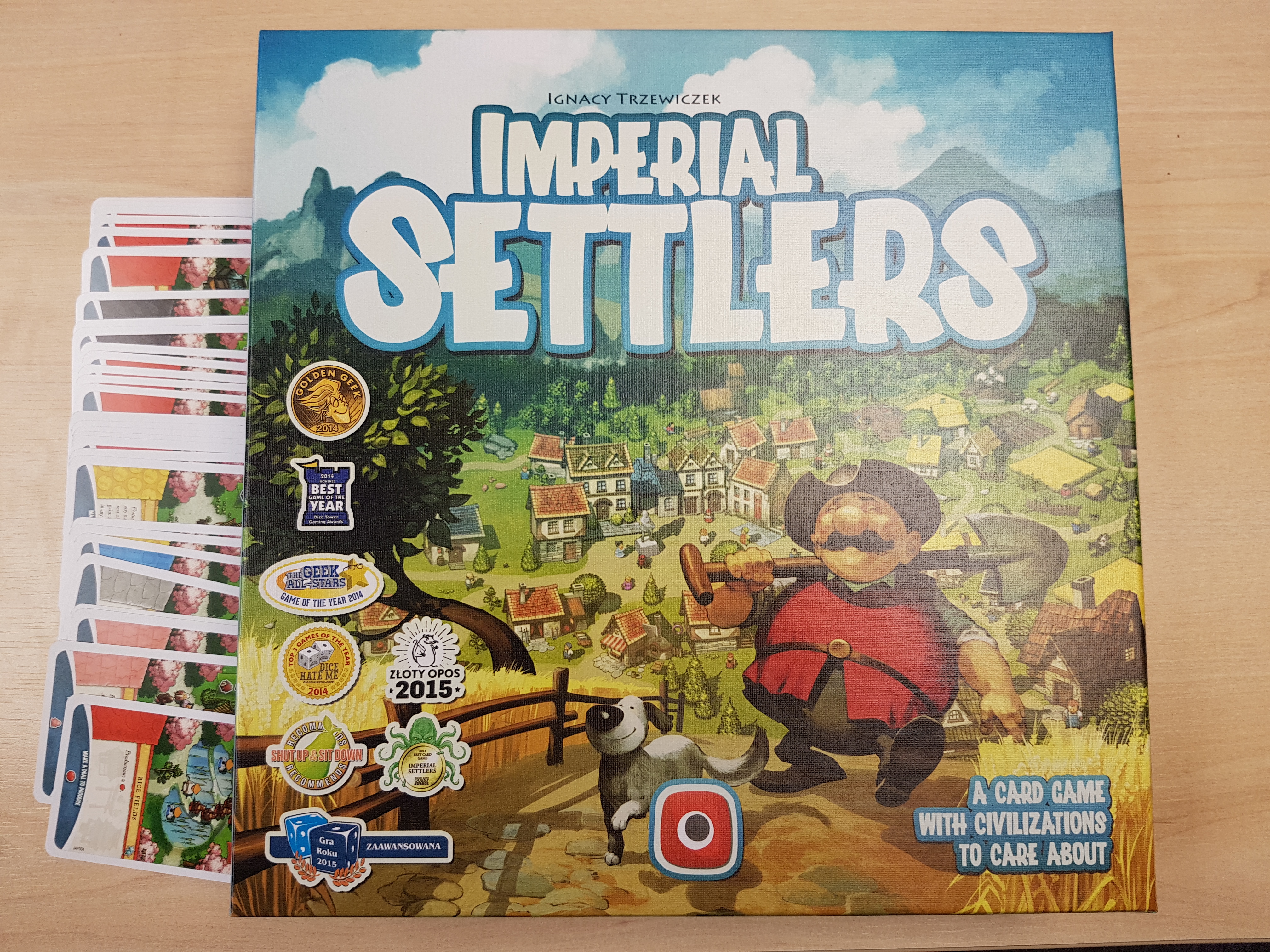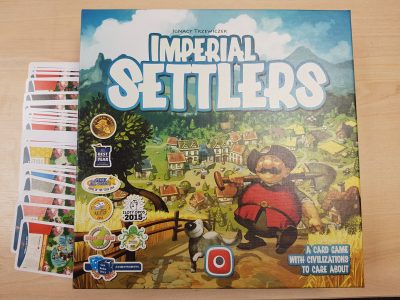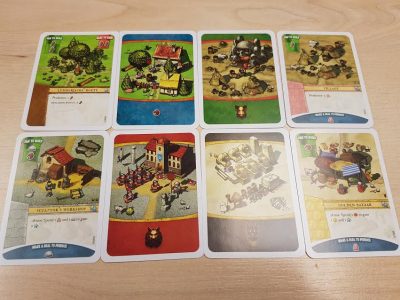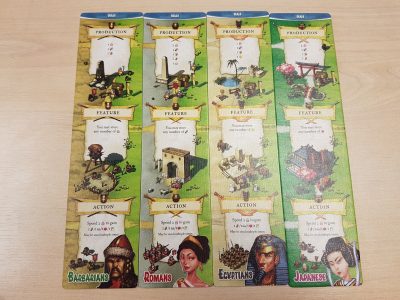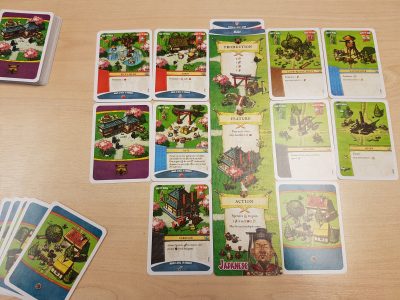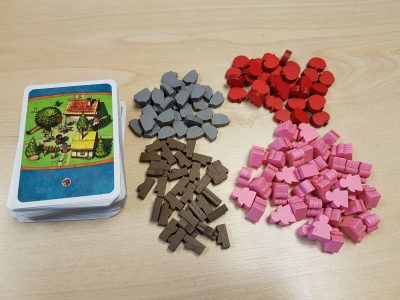Imperial Settlers is an asymmetrical card drafting, engine building, board game from Portal Games. The game sees players take up the role of leaders of four iconic empires: Romans, Barbarians, Egyptians and Japanese. Released back in 2014, there has been a few expansions adding new factions and content to the game however this review focuses on the base game, which is required for all the additional content. So how does the game play?
Being an asymmetrical game, each player must choose one of four the unique factions. While the game suggests starting with a 2-player game of Barbarians vs Romans, the game scales up simply to its maximum of 4 players. Each faction has unique strengths and weaknesses with the Egyptians and Japanese being a tad more complicated, coming with special rules. Egyptians have the ability to take over opponent’s buildings via their Temple of Ra card, while the Japanese can defend with Samurai and raze almost any building card they pick up.
Once factions are selected players take their faction deck, place their faction’s board in front of themselves and put their faction marker at the start of the scoreboard. The bank of components for resources, tokens and common cards is placed within reach of all players. Finally, before the first of five rounds begins, each player draws 2 of their faction cards and 2 common cards. Now the first round commences, with each round being identical.
Each round is made up of four stages: gain cards, production, actions and clean-up. Firstly, players draw one faction card then in turn order players take the top three common cards and then another three common cards. By now players already have 11 cards in their hands, hopefully giving them plenty of options. Next up is production. Players produce any resources available to them from their faction board, any previously made deals and previously built production locations. Unsurprisingly, in round 1 this will just be the faction board.
Now is the action phase. Each player, in turn, takes individual actions until everyone has passed. Whenever a player passes not only can they no longer participate in that round but other players cannot target them either. This action phase is where most of the game happens. Consisting mostly of new buildings being built and some action cards being triggered. Finally is the inevitable clean-up phase. Any unspent resources that cannot be stored by the player are put back into the bank. The first player marker is passed to the next player and the next round starts.
Resources produced include food, wood, stone, workers, cards, raze tokens and defence tokens. Food enables players to make deals with faction cards to produce a resource straight away and in subsequent rounds. Workers are used to trigger the actions on constructed action cards. A single Raze token can be used to discard a common card from your hand and gain the denoted resources. Note, that the Japanese can also Raze faction cards from their hand. Players can also spend two raze tokens to raze and pillage an opponents already built location. Defence tokens raise the number of raze tokens an opponent needs to raze one of your built locations. Lastly, Wood and Stone are used in different amounts to build any building type.
Locations that are built fall into three structures. Like with gaining resources it is often best to build a bit of everything. Common location cards are usually considered worse than faction cards. This is because they are less powerful, offering less victory points, and they can be razed by opponents. However, common cards are cheaper to build and are essential to building most faction cards, which force you to discard an already built location. In early rounds players will most likely focus on production cards. When built these instantly give the denoted resource and in future rounds give resources again. The next type of cards is feature cards. As an example, these allow players to store a type of resource or gain an ongoing bonus when doing specific actions. The final type is Action cards. These range from spending a worker to gain X amount of a resource to trading in a worker and food to gain victory points.
Understanding the way to play cards is only the first stage. determining which work together to produce the things you need, to trade up for more in another round, is key to victory when against experienced players. Everyone is likely to find their personal favourite strategies and you can always look at what your opponents are doing if you want to match them. Keeping an eye on what opponents have built can be key to knowing the most effective building to raze. A double win situation for the player gaining resources and making an opponent discard an already built location.
This gameplay of gaining cards, gaining resources and playing cards is repeated across the five rounds and at the conclusion the victory points from the tracker and buildings are combined and a winner is crowned. Some have previously complained that the game has started to feel repetitive after a few plays. The simple answer to this is vary the faction that you play. Each is different enough to provide experiences that players are bound to enjoy more or less. Finding your favourite is part of the fun.
My biggest issue with this design is that individual cards shine out as the strongest early game cards. If there is ever a best choice the puzzle of what to do is removed and can see some combinations returning to the table time and time again. Naturally, this is always at the mercy of drawing the right cards. Players will have to adapt to what they pick up or face falling behind while waiting to get the perfect combination.
The asymmetrical element is both part of Imperial Settlers strengths and weaknesses. None of the factions feel over powered yet it is also impossible to have a 100% balanced game with each faction being unique. Each will see players utilizing differing tactics to become victorious. This can be off-putting for those new to board games who seemed to prefer the idea of everyone have identical cards. This was very much down to the thoughts of if someone is winning they may have had an unfair advantage based on being a different faction.
Straight away from picking the box up to looking through the cards, players will notice the awesome, almost cute, art style. The cartoony drawn buildings with little guys working on the cards works well with each faction. Despite using the same style each instantly looks unique from just the architecture in the artwork, making it easy to sort cards post game and be a visual treat during play. The components are also extremely nicely designed with the resources being made of wood in distinct colours and shapes which match the icons used on the cards.
One aspect which can negatively affect the experience is luck of the draw. The designers were clearly aware of this. From the constant drawing and producing of cards, by the end of the game players will have a plethora of cards to choose from. Almost, but not quite, negating the luck aspect. As with any game which involves an aspect of engine building, getting decent production cards early on in a game of Imperial Settlers can set a player up for a strong finish.
Early game is key to laying the foundations of the empire you’re building. As a result of this drawing bad cards at the offset can be extremely detrimental. These bad cards can be in the form of buildings you’re unable to easily afford or buildings with actions that don’t match your playstyle. No matter how the card is bad, it can be disheartening from the start to see unlucky card draws see you fall behind.
Pacing-wise Imperial Settlers is a bit of a mixed bag. At 2-players it plays at the right speed and length but higher player counts drive player interactions. At 3 or 4 players the game can drag out a bit, unless all players are on the ball and know what action they wish to take. In a 2 player game the limited player interaction can lead to a “head down” style experience, that can at times feel like two players playing their own separate solo games. The Romans do somewhat break this up as they can store raze tokens for future rounds building up towards razing opponent’s buildings. In a 3+ game player interactions increase, as assumptions as to whom is in the lead are made. Often the pack of “losing” players gang up to raze the buildings of the current leader, dragging them back in line with the others.
I went into Imperial Settlers excited and wanting to love the game because of the artwork and the concept of an asymmetrical faction based engine builder. I’ve come out the other side liking the game. The game will certainly still hit the table and be enjoyed but only with the right people and less frequently than I anticipated. The biggest issue is that some players will lose and deem it down to the faction they played, when in fact it was unlucky card drawing that put them behind. The high-volume of card drawing from the games mechanics does a lot to counter this but if you have a bad start the game may be over before the engine starts to get built. There is entertainment to be had and going in knowing the potential pitfalls will certainly help temper disappointment.
[Editor’s Note: Imperial Settlers was provided to us by Esdevium Games for review purposes. The game is currently available on 365 Games for £29.99. It is also available from local UK board game stores, find your local store here]

